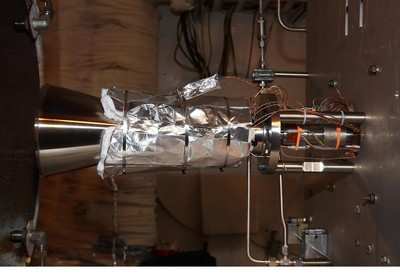Wed, Apr 21, 2010
Aerojet Completes Second Series Of Vibration And Hot Fire Risk
Reduction Engine Tests
Aerojet has successfully completed a second series of vibration
and altitude hot-fire tests on its 160-pound thrust mono-propellant
rocket engine planned for use on NASA's Orion spacecraft. Aerojet
is providing all of the engines for Orion's crew and service
modules for Lockheed Martin.

File Photo
The objective of the test program was
to characterize further engine performance after the thruster was
subjected to Orion crew module vibration loads which are higher
than the engine had been previously tested. Vibration loads applied
to the thruster produced energy levels that were three times the
previously qualified levels, signifying the engine's robust design
capability to withstand substantially higher vibration loads. The
post-vibration altitude hot-fire test sequences mapped the thruster
health over its full operating range ensuring that the engine meets
its mission performance requirements after being subjected to Orion
vibration loads during launch.
The hot-fire test program fully demonstrated the capability to
reach at least 175 pounds of thrust during steady-state firing,
thereby showing an Orion contingency operation during an abort
mission. The firing sequences included 40 millisec. and 120
millisec. pulse mode tests as well as steady-state firings of five
seconds and longer, to demonstrate engine performance health. The
first firing sequence was a seven second steady-state firing at a
feed pressure matching the maximum expected operating pressure
(MEOP) with the thruster at ambient temperature to ensure the test
sequence started at all possible firing conditions following an
abort.
The testing met all objectives, providing additional confidence
that Orion's crew module engine will meet all applicable
performance requirements after being subjected to Orion abort
vibration loads. "This recent testing helps close an identified
risk and provides confidence that Aerojet's MR-104 design for Orion
meets or exceeds the abort mission requirements," said Doug Cosens,
Aerojet's Orion program director. "This effort also illustrates
continued excellent cooperation among Aerojet, Lockheed Martin and
NASA on the Orion project."

The current Orion crew module flight configuration includes 12
MR-104G engines operating at 160 pounds of thrust. The MR-104
engine family originally provided in-space propulsion for the
Voyager 1 and 2 and Magellan missions, and subsequent MR-104
variants provided propulsion for Landsat and NOAA as well as other
U.S. government programs.
Aerojet is part of the nationwide Orion industry team led by
Lockheed Martin, which also includes five major subcontractors and
an expansive network of minor subcontractors and small businesses
working at 88 facilities in 28 states across the country.
More News
Aero Linx: International Federation of Airworthiness (IFA) We aim to be the most internationally respected independent authority on the subject of Airworthiness. IFA uniquely combi>[...]
Ultrahigh Frequency (UHF) The frequency band between 300 and 3,000 MHz. The bank of radio frequencies used for military air/ground voice communications. In some instances this may >[...]
A Few Questions AND Answers To Help You Get MORE Out of ANN! 1) I forgot my password. How do I find it? 1) Easy... click here and give us your e-mail address--we'll send it to you >[...]
From 2019 (YouTube Edition): Learning To Paint Without Getting Any On Your Hands PPG's Aerospace Coatings Academy is a tool designed to teach everything one needs to know about all>[...]
Also: Sustainable Aircraft Test Put Aside, More Falcon 9 Ops, Wyoming ANG Rescue, Oreo Cookie Into Orbit Joby Aviation has reason to celebrate, recently completing its first full t>[...]
 ANN's Daily Aero-Linx (05.06.25)
ANN's Daily Aero-Linx (05.06.25) ANN's Daily Aero-Term (05.06.25): Ultrahigh Frequency (UHF)
ANN's Daily Aero-Term (05.06.25): Ultrahigh Frequency (UHF) ANN FAQ: Q&A 101
ANN FAQ: Q&A 101 Classic Aero-TV: Virtual Reality Painting--PPG Leverages Technology for Training
Classic Aero-TV: Virtual Reality Painting--PPG Leverages Technology for Training Airborne 05.02.25: Joby Crewed Milestone, Diamond Club, Canadian Pilot Insurance
Airborne 05.02.25: Joby Crewed Milestone, Diamond Club, Canadian Pilot Insurance



